Storm water Retrofitting- Photo Essay
If you are planning any renovations to your existing facility (e.g. replacing an old asphalt parking lot, installing roof drains, replacing your roofing, etc.) now may be a good time to look at options for absorbing and keeping clean any runoff that comes into contact with your property. Any renovations made now will improve water quality, protect downstream water bodies, reduce flooding, and can be aesthetically appealing.
 Please
read through the following key points to assist you in creating and
implementing storm water retrofitting plans for your small business
site. Remember, there are many other "after the fact" ideas
for reducing storm water runoff - see "Related Links" (left
margin of most DNR Small Business web pages) for more ideas. Please
read through the following key points to assist you in creating and
implementing storm water retrofitting plans for your small business
site. Remember, there are many other "after the fact" ideas
for reducing storm water runoff - see "Related Links" (left
margin of most DNR Small Business web pages) for more ideas. |
Replacing/Modifying Parking Lots - Pavers, Porous Concrete and Bioretention Islands
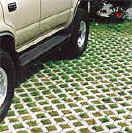 Can
your small business retrofit your existing parking lot? According to Watershed
Protection Techniques [3(2): 647] "parking lots rank among the most
harmful land uses in any watershed. They not only collect pollutants that
are deposited from the atmosphere, but also accumulate pollutants that
leak, drip or wear off cars."
Can
your small business retrofit your existing parking lot? According to Watershed
Protection Techniques [3(2): 647] "parking lots rank among the most
harmful land uses in any watershed. They not only collect pollutants that
are deposited from the atmosphere, but also accumulate pollutants that
leak, drip or wear off cars."
The article also mentions several design ideas such as reducing stall sizes, narrowing drive aisles and using inovative materials and practices such as grid pavers, porous concrete and bioretention islands (photos below) to absorb storm water.
For more information on better site design oprtions, please refer to the following article: "The Benefits of Better Site Design in Commercial Development"- pdf (680 K) Published by the Center for Watershed Protection (EXIT DNR)
Pavers are alternatives to using asphalt and concrete and can be used for parking areas, walkways and driveways. Porous pavement is a permeable (water-absorbing) pavement surface that allows runoff to be treated as it infiltrates back into the soil.
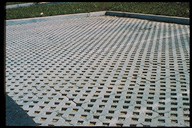
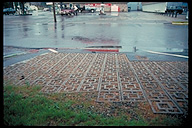
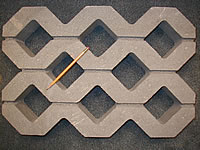
Concrete lattice closeups, Concrete lattice installed in gas station parking lot (above)
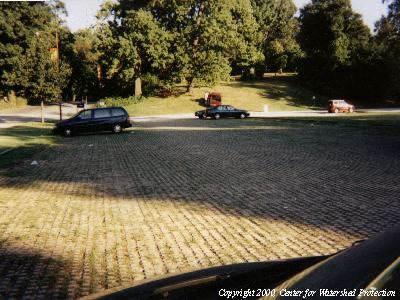
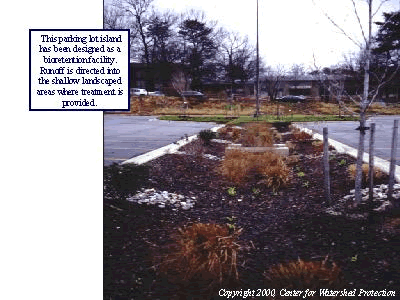
The above two photos used with permission from the Center for Watershed Protection.
Turning Lawn Areas into Native Landscapes
 You
can save dollars earmarked for lawn maintenance by replacing large, high
maintenence mowed areas with native vegetation. Native plants and soils
will also have the greatest long term impact on protecting the watershed
and any nearby water bodies (lakes, rivers and wetland areas) where storm water
runoff ultimately travels to. This up-front planning will save cost associated
with storm sewer fees, lawn creation and maintenance costs, and disposal
charges, to name a few.
You
can save dollars earmarked for lawn maintenance by replacing large, high
maintenence mowed areas with native vegetation. Native plants and soils
will also have the greatest long term impact on protecting the watershed
and any nearby water bodies (lakes, rivers and wetland areas) where storm water
runoff ultimately travels to. This up-front planning will save cost associated
with storm sewer fees, lawn creation and maintenance costs, and disposal
charges, to name a few.
The following three photos illustrate various ways to keep or establish vegetation while allowing access. The three examples are: a woodland, a prairie and a wetland area near small businesses.
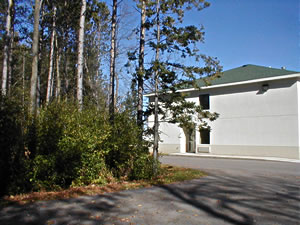
An example of a natural woodland area near a parking lot.
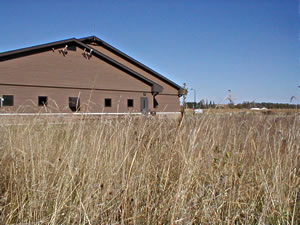
An example of a native prairie planting near a small business.
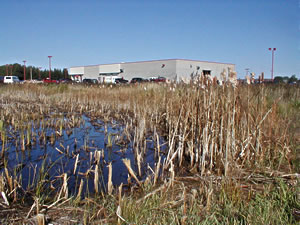
An example of a wetland scrape near a car dealership.
All above photos by Tom Blake and Mike Nordin, WI DNR unless otherwise credited.
Storm water Retrofitting - Long Term Flow Management
Storm water retrofitting includes collecting and treating runoff to save dollars, prevent flooding and protect nearby waterways. The following practices, when used solely, or in combination, will hold back sediment while allowing runoff water to seep slowly back into the ground.
Installing Infiltation Basins and Trenches

Infiltration basins and trenches are used to hold sediment in place, preventing it from choking out and making wetlands ineffective or adding to silty deposits in nearby rivers and lakes. These basins can be very important during larger storms when other storm water management practices cannot treat or recharge runoff as well.
Grassed Swales
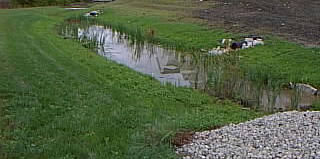 Grassed
swales function by slowing runoff as it comes off an impervious surface
(such as the principal parking area for your business). The grassed
swale can remove sediments and other pollutants and provides some
infiltration into the soil. A drawback, however, is that they can
be ineffective at treating and absorbing runoff during a larger rain
event. Grassed
swales function by slowing runoff as it comes off an impervious surface
(such as the principal parking area for your business). The grassed
swale can remove sediments and other pollutants and provides some
infiltration into the soil. A drawback, however, is that they can
be ineffective at treating and absorbing runoff during a larger rain
event. |
Storm water Wetlands (a.k.a constructed wetlands, artificial wetlands)
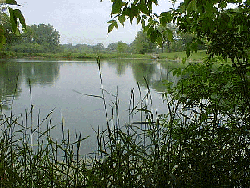 Storm water
wetlands are shallow pools that have wetland plants which remove pollutants
through biological uptake. They are among the most beneficial in removing
pollutants and are aesthetically pleasing, as well. Storm water wetlands
can provide educational and habitat benefits and can be incorporated into
any existing ponds or swales you may already have in place.
Storm water
wetlands are shallow pools that have wetland plants which remove pollutants
through biological uptake. They are among the most beneficial in removing
pollutants and are aesthetically pleasing, as well. Storm water wetlands
can provide educational and habitat benefits and can be incorporated into
any existing ponds or swales you may already have in place.
There are several other practices that can be incorporated into your site design to minimize your impact to the local watershed and save you money. Please refer to the "Related Links" (button found along the left margin of most pages within the Small Business Web Site) topic when you have completed the other topics.